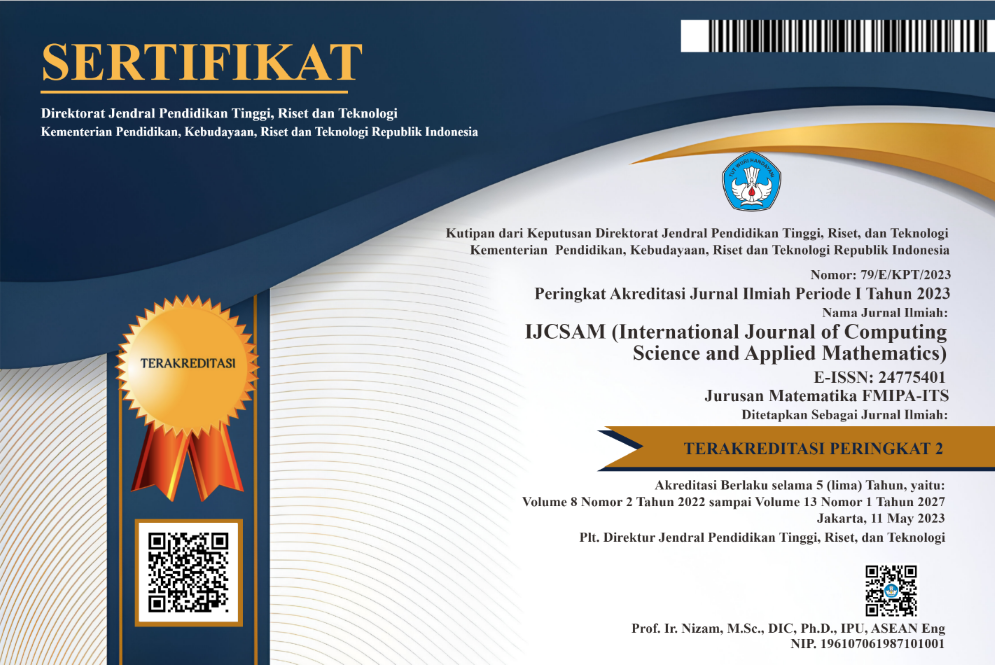Effect of Fear in Leslie-Gower Predator-Prey Model with Beddington-DeAngelis Functional Response Incorporating Prey Refuge
Abstract
Keywords
Full Text:
PDFReferences
S. Pal, N. Pal, S. Samanta, and J. Chattopadhyay, “Fear effect in prey and hunting cooperation among predators in a leslie-gower model,” Math. Biosci. Eng, vol. 16, no. 5, pp. 5146–5179, 2019.
S. Yu, “Global stability of a modified leslie-gower model with beddington-deangelis functional response,” Advances in Difference Equations, vol. 2014, no. 1, pp. 1–14, 2014.
M. Aziz-Alaoui and M. Okiye, “Boundedness and global stability for a predator-prey model with modified leslie-gower and holling-type ii schemes,” Applied Mathematics Letters, vol. 16, no. 7, pp. 1069–1075, 2003.
R. Gupta and P. Chandra, “Bifurcation analysis of modified leslie–gower predator–prey model with michaelis–menten type prey harvesting,” Journal of Mathematical Analysis and Applications, vol. 398, no. 1, pp. 278–295, 2013.
Y. Cai, C. Zhao, W. Wang, and J. Wang, “Dynamics of a leslie–gower predator–prey model with additive allee effect,” Applied Mathematical Modelling, vol. 39, no. 7, pp. 2092–2106, 2015.
F. Fitriah, A. Suryanto, and N. Hidayat, “Numerical study of predatorprey model with beddington-deangelis functional response and prey harvesting,” Journal of Tropical Life Science, vol. 5, no. 2, pp. 105–109, 2015.
C. Holling, “The functional response of predators to prey density and its role in mimicry and population regulation,” The Memoirs of the Entomological Society of Canada, vol. 97, no. S45, pp. 5–60, 1965.
A. Misra and B. Dubey, “A ratio-dependent predator-prey model with delay and harvesting,” Journal of Biological Systems, vol. 18, no. 02, pp. 437–453, 2010.
H. Panigoro, E. Rahmi, N. Achmad, and S. Mahmud, “The influence of additive allee effect and periodic harvesting to the dynamics of lesliegower predator-prey model,” Jambura Journal of Mathematics, vol. 2, no. 2, pp. 87–96, 2020.
A. Firdiansyah, “Effect of prey refuge and harvesting on dynamics of eco-epidemiological model with holling type iii,” Jambura Journal of Mathematics, vol. 3, no. 1, pp. 16–25, 2021.
S. Pal, S. Majhi, S. Mandal, and N. Pal, “Role of fear in a predator–prey model with beddington–deangelis functional response,” Zeitschrift fur Naturforschung A, vol. 74, no. 7, pp. 581–595, 2019.
J. Beddington, “Mutual interference between parasites or predators and its effect on searching efficiency,” The Journal of Animal Ecology, pp. 331–340, 1975.
D. DeAngelis, R. Goldstein, and R. O’Neill, “A model for tropic interaction,” Ecology, vol. 56, no. 4, pp. 881–892, 1975.
S. Lima, “Nonlethal effects in the ecology of predator-prey interactions,” Bioscience, vol. 48, no. 1, pp. 25–34, 1998.
W. Cresswell, “Predation in bird populations,” Journal of Ornithology, vol. 152, no. 1, pp. 251–263, 2011.
K. Pangle, S. Peacor, and O. Johannsson, “Large nonlethal effects of an invasive invertebrate predator on zooplankton population growth rate,” Ecology, vol. 88, no. 2, pp. 402–412, 2007.
K. Altendorf, J. Laundr´e, C. L´opez Gonz´alez, and J. Brown, “Assessing effects of predation risk on foraging behavior of mule deer,” Journal of mammalogy, vol. 82, no. 2, pp. 430–439, 2001.
M. Travers, M. Clinchy, L. Zanette, R. Boonstra, and T. Williams, “Indirect predator effects on clutch size and the cost of egg production,” Ecology Letters, vol. 13, no. 8, pp. 980–988, 2010.
L. Zanette, A. White, M. Allen, and M. Clinchy, “Perceived predation risk reduces the number of offspring songbirds produce per year,” Science, vol. 334, no. 6061, pp. 1398–1401, 2011.
X. Wang, L. Zanette, and X. Zou, “Modelling the fear effect in predator–prey interactions,” Journal of mathematical biology, vol. 73, no. 5, pp. 1179–1204, 2016.
K. Kundu, S. Pal, S. Samanta, A. Sen, and N. Pal, “Impact of fear effect in a discrete-time predator-prey system,” Bull. Calcutta Math. Soc, vol. 110, pp. 245–264, 2018.
S. Samaddar, M. Dhar, and P. Bhattacharya, “Effect of fear on prey–predator dynamics: Exploring the role of prey refuge and additional food,” Chaos: An Interdisciplinary Journal of Nonlinear Science, vol. 30, no. 6, p. 063129, 2020.
A. Firdiansyah, “Dynamics of infected predator-prey system with nonlinear incidence rate and prey in refuge,” Jurnal Matematika MANTIK, vol. 6, no. 2, pp. 123–134, oct 2020.
J. Wang, Y. Cai, S. Fu, and W. Wang, “The effect of the fear factor on the dynamics of a predator-prey model incorporating the prey refuge,” Chaos: An Interdisciplinary Journal of Nonlinear Science, vol. 29, no. 8, p. 083109, 2019.
H. Zhang, Y. Cai, S. Fu, and W. Wang, “Impact of the fear effect in a prey-predator model incorporating a prey refuge,” Applied Mathematics and Computation, vol. 356, pp. 328–337, 2019.
R. Upadhyay and S. Mishra, “Population dynamic consequences of fearful prey in a spatiotemporal predator-prey system.” Mathematical biosciences and engineering: MBE, vol. 16, no. 1, pp. 338–372, 2018.
F. Chen, “On a nonlinear nonautonomous predator–prey model with diffusion and distributed delay,” Journal of Computational and Applied Mathematics, vol. 180, no. 1, pp. 33–49, 2005.
K. Lestari, U. Pasaribu, S. Indratno, and H. Garminia, “Generating roots of cubic polynomials by cardano’s approach on correspondence analysis,” Heliyon, vol. 6, no. 6, p. e03998, 2020.
T. Qiao, Y. Cai, S. Fu, and W. Wang, “Stability and hopf bifurcation in a predator–prey model with the cost of anti-predator behaviors,” International Journal of Bifurcation and Chaos, vol. 29, no. 13, p. 1950185, 2019.
DOI: http://dx.doi.org/10.12962%2Fj24775401.v7i2.8718
Refbacks
- There are currently no refbacks.
View My Stats

International Journal of Computing Science and Applied Mathematics by Pusat Publikasi Ilmiah LPPM, Institut Teknologi Sepuluh Nopember is licensed under a Creative Commons Attribution-ShareAlike 4.0 International License.
Based on a work at https://iptek.its.ac.id/index.php/ijcsam.






